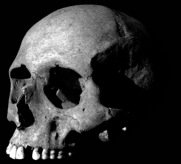supraorbital torus
Full frontal hominins
05/11/09 21:43 Filed in: Palaeoanthropology
One of the most visually striking differences between modern humans and other hominins is the shape of the forehead. The frontal bone of the forehead serves two primary functions: it houses the frontal lobes of the brain in the anterior cranial fossa and also forms the orbital roof. When the orbits are positioned anterior to the frontal lobes, a supraorbital torus or brow ridge, forms in order to bridge the gap. This is particularly the case in archaic members of the genus Homo, whose brain cases are positioned well behind their faces.
The incredible brow ridges of Homo erectus is perhaps this species most salient physical feature. They possess a flattened forehead with a bar-like brow ridge over the eye sockets. The supraorbital torus is continuous and thickened laterally, which in turn is associated with a pinching of the orbital breadth behind the eye sockets, known as postorbital constriction. In H. erectus, the supraorbital torus is separated from the frontal squama by a depression called the posttoral sulcus. While most Erectines conform to this general bauplan, there is a lot of regional variation in the exact form of the torus.
Neandertals are characterised by their long, large, low and wide skull. They have a double-arched browridge above the orbits, which angles backward on the sides of the face. It is depressed along the middle by the presence of a supraglabellar fossa. Compared to H. erectus, Neandertals have a more vertical and rounded forehead, with a less pronounced supraorbital torus. Read More...
The incredible brow ridges of Homo erectus is perhaps this species most salient physical feature. They possess a flattened forehead with a bar-like brow ridge over the eye sockets. The supraorbital torus is continuous and thickened laterally, which in turn is associated with a pinching of the orbital breadth behind the eye sockets, known as postorbital constriction. In H. erectus, the supraorbital torus is separated from the frontal squama by a depression called the posttoral sulcus. While most Erectines conform to this general bauplan, there is a lot of regional variation in the exact form of the torus.
Neandertals are characterised by their long, large, low and wide skull. They have a double-arched browridge above the orbits, which angles backward on the sides of the face. It is depressed along the middle by the presence of a supraglabellar fossa. Compared to H. erectus, Neandertals have a more vertical and rounded forehead, with a less pronounced supraorbital torus. Read More...
0 Comments


